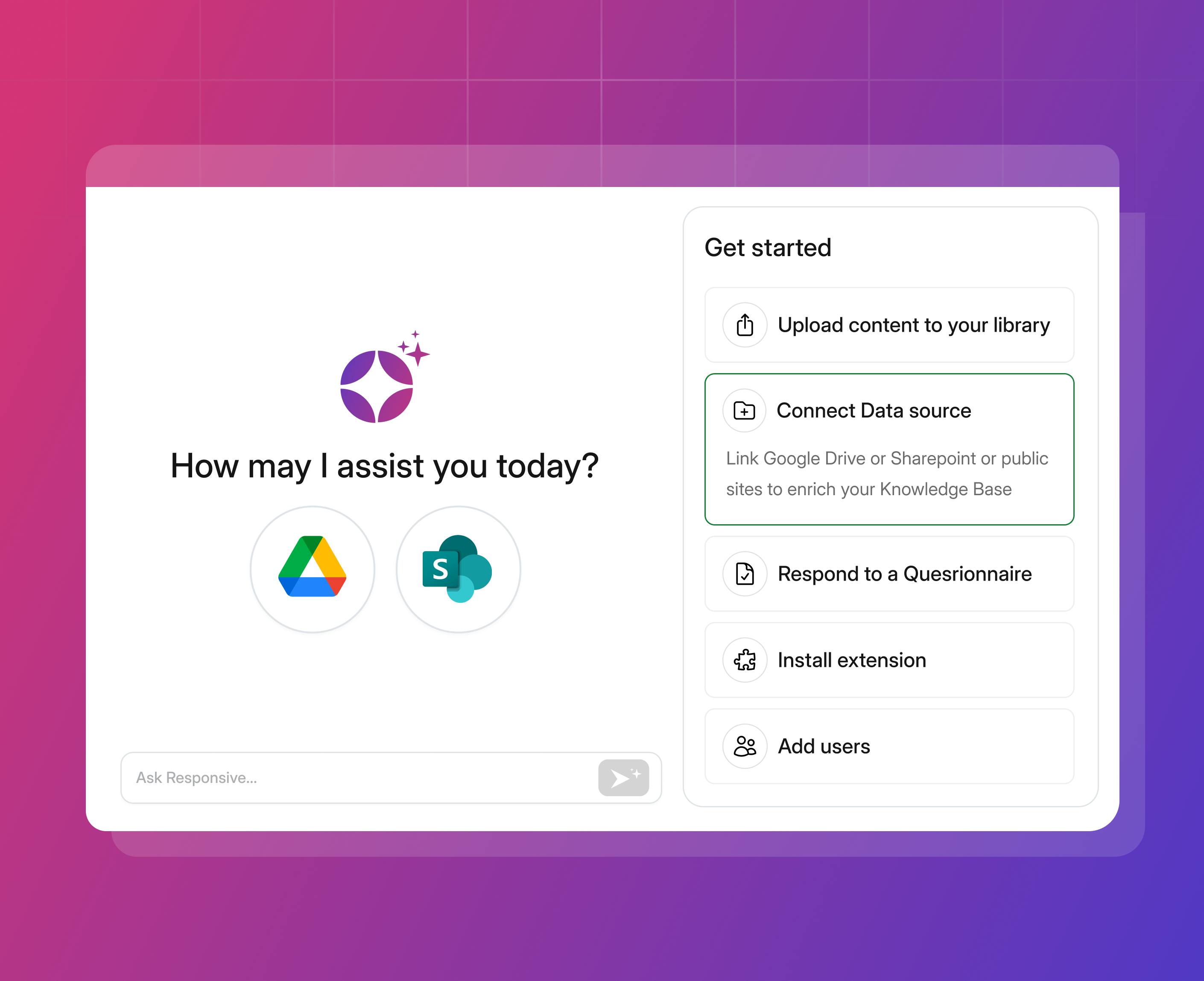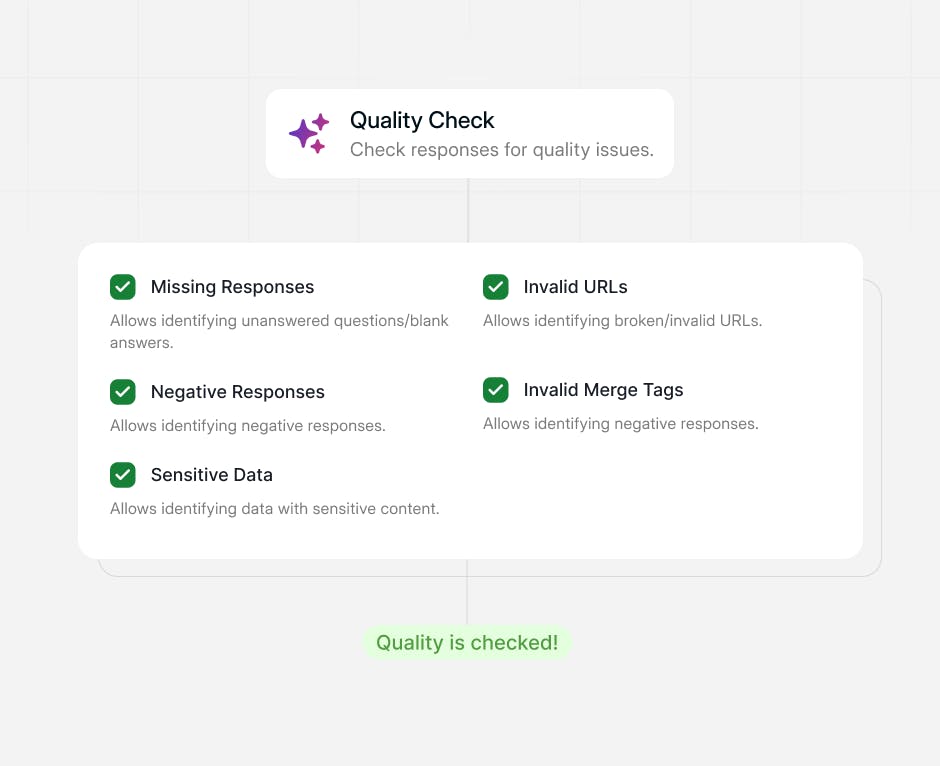Procurement teams are under pressure to do more with less. Teams are handling rising volumes of proposals with tighter turnaround times, increasingly complex approval processes, and fewer people involved in each step of the process. In this environment, your ability to reuse high-quality content quickly and accurately is one of the biggest drivers of proposal success.
According to the 2025 State of Strategic Response Management Report, centralized knowledge is one of the clearest indicators of performance. High-growth teams are 53% more likely to have implemented a centralized content library and 63% more likely to make that content accessible through self-service tools for adjacent teams like sales and pre-sales.
AI can help scale proposal response workflows, but only if the content it pulls from is clean, current, and usable. This is because a well-maintained knowledge base supports response teams by unlocking efficiency across sourcing, compliance, security, legal, and operations teams.
In this post, we’ll review
- What goes into a high-performing tender content library
- How to structure it for self-service and scale
- How to use AI and analytics to keep it optimized over time
Whether you're building from the ground up or refining what’s already in place, the strategies here will help you create a knowledge base that supports faster responses and confident collaboration across teams.
What belongs in a high-quality tender content library
A strong knowledge base begins with the right foundation. Rather than focusing on volume, it’s about relevance, quality, and structure. A lean, well-organized library will outperform a large, unstructured one every time.
Reusable content types
Start by gathering your most commonly requested content. Most procurement and proposal teams rely on a consistent set of materials that appear across nearly every tender or RFX. These typically include:
- Company overviews and boilerplate language
- Product descriptions and feature summaries
- Pricing models and commercial terms
- Security standards and IT protocols
- Legal clauses and certifications
- Implementation timelines and onboarding steps
- Customer case studies and references
Before uploading anything into your library, it’s worth taking stock of what already exists. Review past responses and identify what’s accurate, what’s outdated, and where teams tend to go searching for answers. This kind of audit doesn’t have to be exhaustive; it just needs to give you a clear starting point for curation. If a piece of content is frequently requested or manually reworded, it likely belongs in your library.
For additional guidance on what content to prioritize — and how to keep it useful across evolving RFP formats — these best practices for bid and tender responses offer a helpful reference point.

Modular building blocks vs. static templates: what to prioritize
Once you’ve identified your core content, the next step is to structure it for flexibility. That means avoiding static, one-size-fits-all templates and instead organizing your knowledge into modular blocks.
These smaller, reusable components — like a paragraph on SOC 2 controls or a two-line onboarding summary — can be assembled based on the specific requirements of each tender. Modular content is easier to maintain and allows AI to return more targeted results, especially when entries are tagged by topic, persona, product line, and approval status.
Tagging and metadata also support stronger governance. With the Responsive Platform, you can apply version history, ownership fields, and access controls to each entry, ensuring your team is always working with accurate, approved content. And because AI performance depends on the quality of the data it pulls from, these structural details can make a real impact on the speed and accuracy of your responses.
For a deeper look at how content fits into the broader tender process, this post on tender management offers helpful context.
How to structure your library for self-service and scale
As the volume and velocity of tender requests increase, proposal managers and sourcing leaders can’t afford to be bottlenecks. The most effective teams make it easy for collaborators across Sales, pre-Sales, Legal, InfoSec, and more to self-serve — finding and using approved content without waiting for manual support. That requires a well-structured library, not just a content dump.
Responsive helps procurement teams scale by offering a centralized, searchable repository built for reuse and governance. Key capabilities include:
- Centralized repository designed for reuse, with governance baked in.
- Modular entries (e.g., pricing disclaimers, onboarding timelines, security policy summaries) tagged by product, industry, geography, or approval status.
- Version history, usage metrics, and ownership fields that keep content accurate and findable.
- Access controls at the folder or entry level, balancing broad search with internal policy boundaries.
- AI-enabled access through Ask and LookUp, allowing stakeholders to insert approved content directly in Word, Chrome, or online portals without switching tabs.
- TRACE Score™ quality signal that indicates whether entries are current, complete, and ready to use.
It’s this combination of structure, trust, and accessibility that streamlines internal workflows and delivers measurable results. Qualtrics, for example, leveraged Responsive AI to cut time to tailored first draft in half, empowering thousands of SMEs and field sellers to access a centralized knowledge base through tools like Ask by Responsive and Responsive LookUp. This secure, AI-enhanced environment — combined with seamless onboarding and enterprise-level support — scaled consistent, accurate responses across teams and significantly boosted efficiency while maintaining compliance.
How to drive growth amid longer sales cycles
Best practices for keeping RFP content accurate and relevant
Outdated or incomplete information will quickly render a knowledge base unhelpful and frustrating. High-performing teams ensure that their proposal content stays accurate by building structured processes around content ownership, review, and feedback. The more clearly those processes are defined, the easier it becomes to maintain confidence in every response.
Best practices include:
- Assign content owners: Each entry should have a designated owner — often someone from Legal, InfoSec, Product Development, or Procurement — responsible for regular updates. Responsive allows teams to define ownership so accountability is clear and collaboration moves faster.
- Set review cycles: Review content based on both strategic importance and usage frequency. Responsive supports this with version tracking, usage metrics, and TRACE Score™, while Agent Studio can automate reminders or trigger reviews when usage patterns change.
- Incorporate customer feedback: Frequent edits during the RFP process signal that a content entry needs attention. Capturing reviewer feedback improves accuracy and reduces unnecessary SME involvement.
- Automate workflows: With Agent Studio — a no-code environment for building and deploying AI agents — teams can surface underperforming content, notify SMEs when updates are due, and apply rules to keep the library clean and usable.
OC Tanner demonstrates the value of this approach. By embedding reviewer feedback into their update process, they eliminated duplicate entries, streamlined approvals, and reduced SME involvement, ultimately saving $150,000 per year.
These practices, reinforced by automation, reduce manual overhead and allow proposal and sourcing teams to focus their time on the opportunities that matter most.
Using AI to maintain and optimize your knowledge base
In the race to scale with AI, you can think of your content library as the mine and quality output as the gold. If what’s inside your content library is outdated, duplicative, or poorly structured, even the most advanced AI tools will struggle to produce anything valuable. But with the right content in place, AI can speed up reviews, flag problems before they cause delays, and help teams build stronger responses with less manual effort.
Responsive AI supports the entire content lifecycle with capabilities such as:
- Automated tagging and classification of entries for easier retrieval.
- Duplicate detection to remove redundant content.
- Update suggestions when entries are outdated or low quality.
- Retirement recommendations for content that hasn’t been used recently.
- Data-driven insights based on usage frequency, edit history, and quality metrics such as length, clarity, and formatting.
- Contextual retrieval that surfaces accurate, relevant answers during questionnaires or proposal drafting.
- Version-controlled content blocks that ensure responses remain current and reliable.
Microsoft’s team adopted this approach and saw measurable gains: proposal library usage jumped 60%, and teams saved 30 minutes per question by surfacing vetted content through AI-powered search instead of starting from scratch. Boosting your bottom line by improving your RFP process like Microsoft did doesn’t require reinventing your process — it starts with building a better content foundation and letting AI do the heavy lifting.

Measuring impact: How to know your library is working
A well-managed knowledge base should produce clear, measurable results. When it’s working, teams respond faster, reuse more content, and rely less on SMEs for everyday requests. These improvements stem from deliberate measurement and continuous improvement feedback loops that connect content performance with business objectives.
According to the 2025 State of Strategic Response Management Report, high-growth teams are significantly more likely to track and act on content-related KPIs. This is because they’re focused on how well their knowledge assets perform across the proposal lifecycle and beyond, not merely on output volume.
KPIs to track and why
To understand whether your content library is delivering real value, look beyond usage logs and track how it affects performance across the entire response process. The right KPIs can help you identify what's working, where to focus improvements, and how to communicate your team’s impact internally. These metrics can also guide content strategy decisions as your library evolves.
- Response speed: Time from assignment to submission, especially for high-value tenders
- Content reuse rate: Percentage of RFPs that use approved content blocks
- Win rate: Particularly for tenders that use curated, AI-ready responses
- SME workload: Number of requests routed to SMEs vs. handled through self-service
With Responsive’s analytics, teams can track these metrics in one place, making it easier to spot trends, flag underused content, and demonstrate impact to stakeholders.
How proposal teams can quantify and communicate their impact
Proposal and procurement teams often operate behind the scenes, but a strong knowledge base is a measurable way to show your team’s value:
- Perceptyx assembles first-draft responses in just 30 minutes using Responsive AI agents, enabling their four-person RFP team to handle 75 proposals and 150 VSQs annually without adding headcount, while independently answering 90% of VSQs before they reach InfoSec.
- Availity advanced 88% of its deals to the next stage with Responsive AI, while 50% of all RFPs, RFIs, and VSQs are now completed automatically, dramatically accelerating turnaround from weeks to mere hours and maintaining a 100% on-time submission rate.
Sharing these kinds of results internally builds momentum and helps secure support for continued investment in content governance, SME engagement, and AI tooling.
Closing the loop: Using pursuit data to refine content strategy over time
Tracking content usage also allows teams to improve their library based on what’s actually working. Responsive enables teams to review past responses, analyze win/loss outcomes, and identify which content blocks contribute to stronger results. If certain product descriptions or customer stories appear in more winning proposals, those entries can be reinforced or highlighted in future responses.
Pursuit data becomes even more valuable over time. Teams can use it to sunset stale content, identify knowledge gaps, and refine how information is tagged or structured. When you connect what’s in your library to what’s driving wins, you turn content management into a strategic advantage.
Responsive helps build and manage your tender content library
Your knowledge base is one of the most powerful assets your team can build. When it's current, modular, and accessible across the organization, it ticks every box: your team can move faster, stay aligned, and increase confidence in every response.
Responsive is purpose-built to support this approach:
- With workflow orchestration, you can centralize and manage reusable content, assign owners, and apply approval workflows.
- With Ask and LookUp, teams can access that content in their native work environments, without switching tools.
- Responsive AI powers intelligent content suggestions, tagging, cleanup, and draft generation.
- Business intelligence gives you insight into what’s working and where to improve.
Maintel uses Responsive to unify responses, keep content accurate, and cut manual effort. With centralized workflows, their team improved compliance and freed employees to focus on higher-value work. They now submit 25% more tenders with the same resources, proving the efficiency unlocked by the right content structure.
Ready to see how your team can get results, too?
